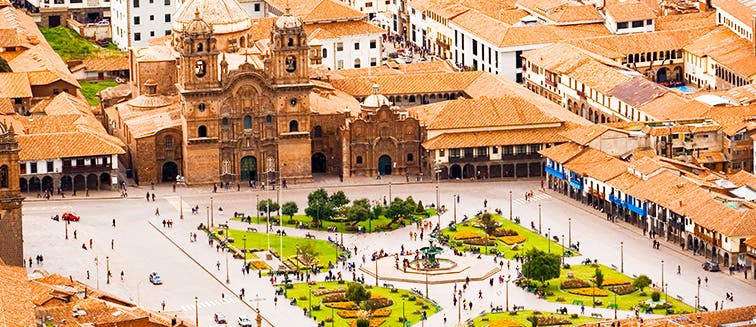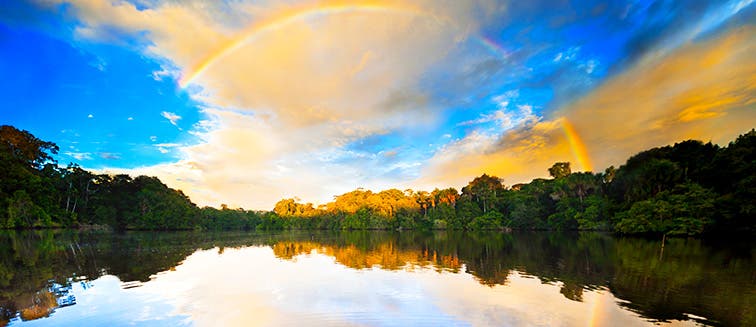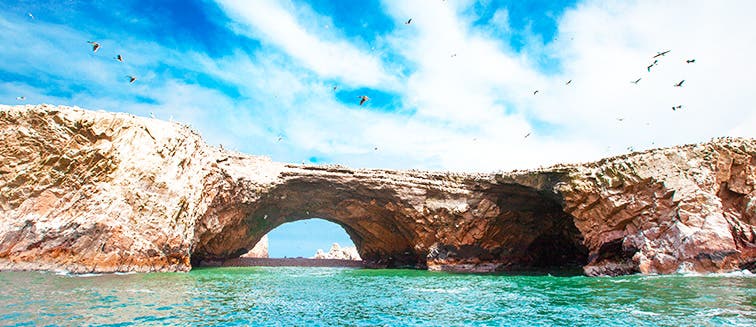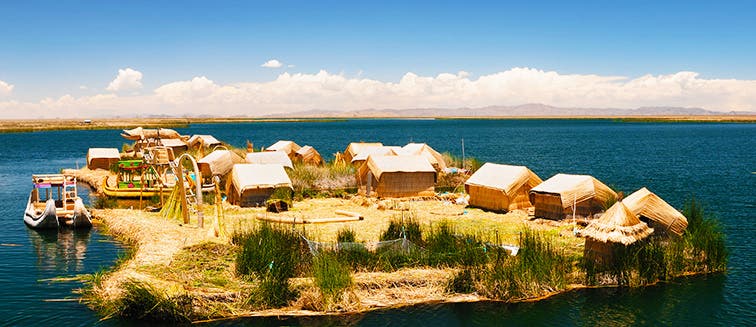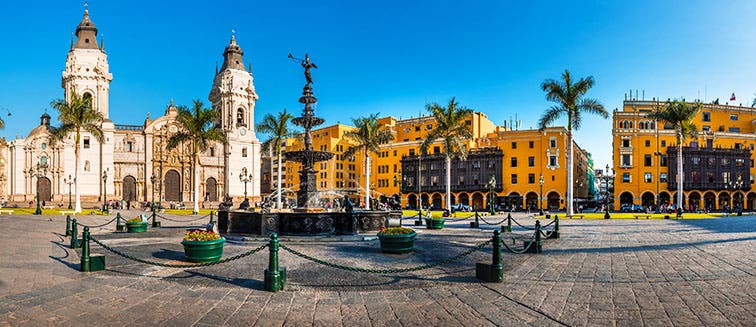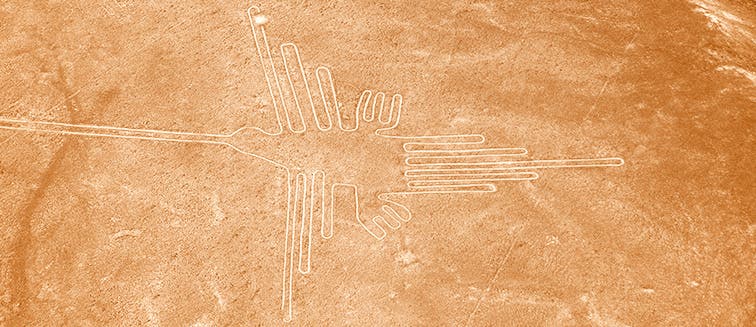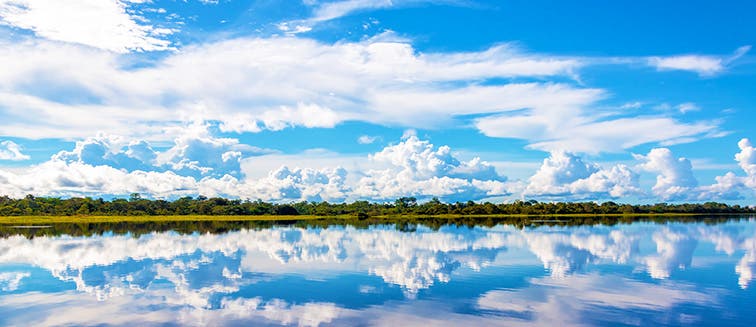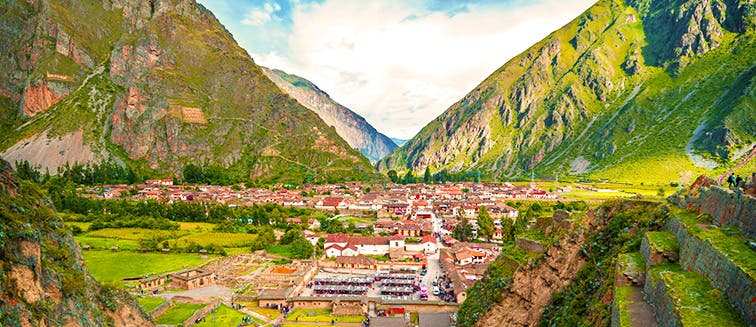Africa
Americas
Asia
Europe
Oceania
Holidays to Europe (94 available)
Albania(2)
Austria(6)
Baltic States(3)
Belgium(5)
Croatia(3)
Cyprus(1)
Czech Republic(5)
Denmark(1)
England(10)
Finland(2)
France(13)
Germany(7)
Greece(10)
Holland(5)
Hungary(4)
Iceland(6)
Ireland(9)
Italy(13)
Montenegro(1)
Northern Ireland(2)
Norway(9)
Portugal(10)
Romania(1)
Scotland(6)
Slovakia(1)
Spain(9)
Sweden(2)
Switzerland(4)
By Season
By Interest
By Group
Advisors hotline: +1 778-743-2337
Mon - Fri: 9am - 9pm EST
Saturday: 9am - 6pm EST
Sunday: Closed
What to see in Peru
Machu Picchu
Tourist attractions Machu Picchu
An ancient Incan citadel and top of most travelers bucket-list, Machu Picchu is an awe-inspiring sight and a must-see for all intrepid travelers. Perched at 2,430 meters in the eastern mountains of Peru, Macchu Picchu has enchanted all who have made the journey to see its ancient ruins since its rediscovery in 1911.
Constructed in a classical Inca style the monument is a protected UNESCO World Heritage Site and a major attraction for all who choose to travel to Peru. As the world’s most recognizable icon of the Inca civilization, Machu Picchu dates back to around 1450 and is nestled between breathtaking mountain peaks, making for spectacular views and photo opportunities for those on a tour of Machu Picchu.
As well as its amazing backdrop, there are three main structures to explore within the site itself: Intihuatana, a ritual stone sculpture, the Temple of the Sun and the Room of Three Windows. There are also hundreds of man-made terraces, historically used for complex farming techniques, and a charming population of native llamas.
Routes to Machu Picchu
There are different options on how to travel to Machu Picchu, but the most accessible and popular route is to take the scenic train from Cuzco or the Sacred Valley to Aguas Calientes, the nearest town to the monument. From here, you can reach the entrance either on foot or by an array of transport services available in the town.
Alternatively, the most intrepid travelers might opt to trek the Inca Trail. The full Inca Trail can take four to five days of moderate trekking to complete, although shorter and one-day options are also available to enable everyone to feel the accomplishment of completing the hike to Machu Picchu.
Significance of Machu Picchu
Machu Picchu is one of the most popular destinations for travelers on a trip to Peru, although many visitors know little about the history and significance of this ancient monument. By uncovering some of the theories about why Machu Picchu was built, travelers might find their visit an even more eye-opening experience.
History and Theories
On the most part, Machu Picchu was unknown to anyone outside of the region until 1911, when American archaeologist, Hiram Bingham, discovered and consequently shared this secret of the Incas with the rest of the world. Led by the locals, the archaeologist unearthed the so-called ‘Lost City of the Incas’ and proceeded to excavate the site whilst forming theories about its curious history. Bingham later published a book outlining his theories on the history of the site, inspiring globe-trotters from around the world to travel to Machu Picchu.
Macchu Picchu is thought to have been constructed around 1450, at the height of the powerful Inca Empire. It is suspected that the site was completely abandoned just 80 years after its construction, sparking enthusiastic debate about the original purpose of this mysterious monument.
The most widely accepted theory suggests that Machu Picchu served as a royal estate for Inca kings during the hot summer months due to its cool, high-altitude climate. The structure of the monument reveals a three-class structure, with different buildings appropriate for housing both royalty, nobles, and servants. Complex irrigation systems and farming terraces also point to the monument once functioning as a self-sufficient hilltop retreat. On the other hand, some believe that the monument was built to serve a spiritual purpose as a center for important religious ceremonies.
The Incas worshipped the sun, due to its life-giving properties, and Macchu Picchu and its buildings are in direct alignment with the surrounding mountains that frame, perfectly, the sun rises and sunsets during equinoxes and solstices, which would have been important, spiritual events for Inca society.
A final theory to keep in mind if you visit Machu Picchu is that the sheer height at which the monument was built suggests it held immense value to the Inca civilization. It’s speculated that Machu Picchu was the final stop on a grueling pilgrimage route, beginning in Cuzco and culminating at the peak of the monument. If you trek the Inca Trail, you can surely sympathize with these ancient Inca pilgrims.
Travel Logistics and Practical Information
Best Time to Visit
- Dry Season (May to October): Ideal for trekking, with clear skies and cooler temperatures.
- Wet Season (November to April): Lush landscapes but higher chances of rain. Best for photography enthusiasts.
Packing Essentials
- Comfortable trekking shoes
- Lightweight, waterproof clothing layers
- Sunscreen, insect repellent, and a reusable water bottle
- Altitude sickness medication (consult your doctor)
- Passport (Canadian citizens do not need a visa for stays up to 183 days. Ensure your passport is valid for at least six months beyond your planned departure date.)
Altitude and Acclimatization
- Altitude: Ranges from 2,400 to 4,200 meters (7,874 to 13,780 feet) on trekking routes.
- Tips to adjust: Spend a day or two in Cusco to acclimate, stay hydrated, and avoid strenuous activity on your first day. Always talk to your doctor before traveling to Machu Picchu.
Why choose Exoticca for your Machu Picchu adventure?
- Expertly curated tours tailored to your preferences.
- Trusted operators with a focus on responsible tourism.
- Exclusive itineraries designed for Canadian travelers.
OUR BEST TRIPS TO MACHU PICCHU
YOU ALSO LIKE
Tourist attractions peru
Points of interests
- Trips to Aguas Calientes
- Trips to Arequipa
- Trips to Colca Canyon
- Trips to Cuzco
- Trips to Huacachina Oasis
- Trips to Iquitos
- Trips to Islas Ballestas
- Trips to Lake Titicaca
- Trips to Lima
- Trips to Machu Picchu
- Trips to Nazca
- Trips to Paracas
- Trips to Puerto Maldonado
- Trips to Sacred Valley
Other Points of interests
- Trips to Amazon
- Trips to Argentinian Patagonia
- Trips to Atacama Desert
- Trips to Banos
- Trips to Baquerizo Moreno
- Trips to Bariloche
- Trips to Barrio La Boca
- Trips to Bogota
- Trips to Buenos Aires
- Trips to Buzios
- Trips to Cartagena de Indias
- Trips to Chilean Patagonia
- Trips to Christ the Redeemer
- Trips to Comuna 13
- Trips to Copacabana Beach
- Trips to Cotopaxi National Park
- Trips to Cuenca
- Trips to Easter Island
- Trips to Eduardo Avaroa
- Trips to El Calafate
- Trips to Galapagos Islands
- Trips to Getsemani
- Trips to Guayaquil
- Trips to Iguazu Falls
- Trips to Iguazu Falls
- Trips to Ilha Grande
- Trips to Isabela Island
- Trips to Islas del Rosario
- Trips to La Candelaria
- Trips to La Loberia Beach
- Trips to La Paz
- Trips to Lake Titicaca
- Trips to Luna Valley
- Trips to Manaus
- Trips to Medellín
- Trips to Mendoza
- Trips to Middle of the World Monument
- Trips to Mindo
- Trips to Otavalo
- Trips to Paraty
- Trips to Perito Moreno
- Trips to Potosi & Cerro Rico
- Trips to Praia do Forte
- Trips to Puerto Natales
- Trips to Quilotoa
- Trips to Quito
- Trips to Rapa Nui National Park
- Trips to Reserva Nacional Los Flamencos
- Trips to Rio de Janeiro
- Trips to Riobamba
- Trips to Ruins of Ingapirca
- Trips to Salar de Uyuni
- Trips to Salvador
- Trips to San Andrés
- Trips to San Cristobal Island
- Trips to San Felipe de Barajas Castle
- Trips to San Pedro de Atacama
- Trips to San Rafael Glacier
- Trips to San Telmo
- Trips to Santa Cruz Island
- Trips to Santa Lucía Hill
- Trips to Santa Marta
- Trips to Santiago de Chile
- Trips to São Paulo
- Trips to Serrano & Balmaceda Glaciers
- Trips to Sucre
- Trips to Tayrona
- Trips to The Devil's Nose
- Trips to Tiahuanaco Ruins
- Trips to Torres del Paine National Park
- Trips to Ushuaia
- Trips to Valley of the Moon
- Trips to Valparaiso
- Trips to Vicente Perez Rosales National Park
- Trips to Viña del Mar
Countries Nearby
- Argentina Trips
- Bahamas Trips
- Belize Trips
- Bolivia Trips
- Brazil Trips
- Canada Trips
- Chile Trips
- Colombia Trips
- Costa Rica Trips
- Dominican Republic Trips
- Ecuador Trips
- El Salvador Trips
- Guatemala Trips
- Honduras Trips
- Mexico Trips
- Panama Trips
- Peru Trips
- United States Trips
Trip Styles
- Argentina Nature Vacation Packages Trips
- Chile Nature Vacation Packages Trips
- Costa Rica Nature Vacations Trips
- Ecuador Cultural Tour Packages Trips
- Ecuador Nature Vacations Trips
- Guatemala Nature Vacation Packages Trips
- Guatemala Cultural Tours Trips
- Peru Tours for Couples - Exoticca Trips
- Peru Cultural Tours Trips
- Peru Nature Vacation Packages Trips




